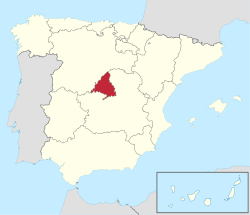
Back Comunidat de Madrit AN منطقة مدريد Arabic ܡܕܪܝܕ (ܗܘܦܪܟܝܐ) ARC مجتمع مدريد ARZ Comunidá de Madrid AST Madrid (muxtar birlik) Azerbaijani Komunitas Madrid BAN Мадрыд (аўтаномная супольнасць) Byelorussian Мадрыд (аўтаномная супольнасьць) BE-X-OLD Мадридска област Bulgarian
Community of Madrid
Comunidad de Madrid | |
|---|---|
| Anthem: "Himno de la Comunidad de Madrid" "Anthem of the Community of Madrid" | |
 Location of the Community of Madrid within Spain | |
| Coordinates: 40°30′N 3°40′W / 40.500°N 3.667°W | |
| Country | Spain |
| Capital | Madrid |
| Government | |
| • President | Isabel Díaz Ayuso (PP) |
| • Legislature | Assembly of Madrid |
| • Executive | Government of the Community of Madrid |
| Area | |
• Total | 8,028 km2 (3,100 sq mi) |
| Ranked 12th, 1.6% of Spain | |
| Population (2024) | |
• Total | 7,058,041[1] |
| • Density | 879.17/km2 (2,277.0/sq mi) |
| • Pop. rank | 3rd |
| • Percent | 14.2% of Spain |
| Demonym | Madrilenian • Madrilene madrileño • madrileña |
| GDP | |
| • Total | €293.069 billion (2023) |
| • Per capita | €42,198 (2023) |
| ISO 3166-2 | ES-MD |
| Official languages | Spanish |
| Statute of Autonomy | 1 March 1983 |
| HDI (2021) | 0.940[3] very high · 1st |
| Congress seats | 37 (of 350) |
| Senate seats | 11 (of 265) |
| Website | comunidad.madrid |
 | |
The Community of Madrid (Spanish: Comunidad de Madrid; [komuniˈðað ðe maˈðɾið] ⓘ) is one of the seventeen autonomous communities and 50 provinces of Spain. It is located in the centre of the Iberian Peninsula, and of the Central Plateau (Meseta Central). Its capital and largest municipality is Madrid, which is also the capital of the country. The Community of Madrid is bounded to the south and east by Castilla–La Mancha and to the north and west by Castile and León. It was formally created in 1983, in order to address the particular status of the city of Madrid as the capital of the Spanish State and in urban hierarchy.[4] Its boundaries are coextensive with those of the province of Madrid, which was until then conventionally included in the historical region of New Castile (Castilla la Nueva).
The Community of Madrid is the third most populous in Spain with 7,058,041 (2024) inhabitants, roughly a seventh of the national total, mostly concentrated in the metropolitan area of Madrid.[5] It is also the most densely populated autonomous community. Madrid has both the largest nominal GDP, slightly ahead of that of Catalonia,[6] and the highest GDP per capita in the country.[7] Madrid's economy is highly tertiarised,[8] having a leading role in Spain's logistics and transportation.
The Community of Madrid is almost entirely comprised in the Tagus Basin, from the Central System (Sistema Central) reliefs in the north and northwest to the Tagus River bed in the southern border. The climate is generally temperate, ranging from mediterranean to semi-arid, except in the Central System highlands. It contains four World Heritage Sites: the Monastery and Royal Site of El Escorial, the university and historic centre of Alcalá de Henares, the cultural landscape of Aranjuez and the Paseo del Prado and Buen Retiro park in Madrid City. In addition, the Montejo Beech Forest is part of the transnational Ancient and Primeval Beech Forests of the Carpathians and Other Regions of Europe world heritage site.
- ^ "Population of the autonomous communities". Datosmacro.com. 4 June 2023.
- ^ "Contabilidad Regional de España" (PDF). www.ine.es.
- ^ "Sub-national HDI - Area Database - Global Data Lab". hdi.globaldatalab.org. Retrieved 24 June 2023.
- ^ "Sinopsis del estatuto de Autonomía de la Comunidad de Madrid". app.congreso.es. Retrieved 16 November 2023.
- ^ "La economía de la Comunidad de Madrid, una de las más potentes y dinámicas del país". Archived from the original on 17 December 2009. Retrieved 9 April 2008.
- ^ "Madrid supera a Catalunya como comunidad con más PIB". La Vanguardia (in Spanish). 20 December 2019. Retrieved 15 May 2020.
- ^ "INEbase / Economía /Cuentas económicas /Contabilidad regional de España / Resultados". INE (in Spanish). Retrieved 16 November 2023.
- ^ "Ocupados por sector económico, sexo y comunidad autónoma. Porcentajes respecto del total de cada comunidad(4949)". INE (in Spanish). Retrieved 16 November 2023.

